Minrui Xu
Sherman
R&D-Agent-Quant: A Multi-Agent Framework for Data-Centric Factors and Model Joint Optimization
May 21, 2025



Abstract:Financial markets pose fundamental challenges for asset return prediction due to their high dimensionality, non-stationarity, and persistent volatility. Despite advances in large language models and multi-agent systems, current quantitative research pipelines suffer from limited automation, weak interpretability, and fragmented coordination across key components such as factor mining and model innovation. In this paper, we propose R&D-Agent for Quantitative Finance, in short RD-Agent(Q), the first data-centric multi-agent framework designed to automate the full-stack research and development of quantitative strategies via coordinated factor-model co-optimization. RD-Agent(Q) decomposes the quant process into two iterative stages: a Research stage that dynamically sets goal-aligned prompts, formulates hypotheses based on domain priors, and maps them to concrete tasks, and a Development stage that employs a code-generation agent, Co-STEER, to implement task-specific code, which is then executed in real-market backtests. The two stages are connected through a feedback stage that thoroughly evaluates experimental outcomes and informs subsequent iterations, with a multi-armed bandit scheduler for adaptive direction selection. Empirically, RD-Agent(Q) achieves up to 2X higher annualized returns than classical factor libraries using 70% fewer factors, and outperforms state-of-the-art deep time-series models on real markets. Its joint factor-model optimization delivers a strong balance between predictive accuracy and strategy robustness. Our code is available at: https://github.com/microsoft/RD-Agent.
R&D-Agent: Automating Data-Driven AI Solution Building Through LLM-Powered Automated Research, Development, and Evolution
May 20, 2025Abstract:Recent advances in AI and ML have transformed data science, yet increasing complexity and expertise requirements continue to hinder progress. While crowdsourcing platforms alleviate some challenges, high-level data science tasks remain labor-intensive and iterative. To overcome these limitations, we introduce R&D-Agent, a dual-agent framework for iterative exploration. The Researcher agent uses performance feedback to generate ideas, while the Developer agent refines code based on error feedback. By enabling multiple parallel exploration traces that merge and enhance one another, R&D-Agent narrows the gap between automated solutions and expert-level performance. Evaluated on MLE-Bench, R&D-Agent emerges as the top-performing machine learning engineering agent, demonstrating its potential to accelerate innovation and improve precision across diverse data science applications. We have open-sourced R&D-Agent on GitHub: https://github.com/microsoft/RD-Agent.
Shadow Wireless Intelligence: Large Language Model-Driven Reasoning in Covert Communications
May 07, 2025Abstract:Covert Communications (CC) can secure sensitive transmissions in industrial, military, and mission-critical applications within 6G wireless networks. However, traditional optimization methods based on Artificial Noise (AN), power control, and channel manipulation might not adapt to dynamic and adversarial environments due to the high dimensionality, nonlinearity, and stringent real-time covertness requirements. To bridge this gap, we introduce Shadow Wireless Intelligence (SWI), which integrates the reasoning capabilities of Large Language Models (LLMs) with retrieval-augmented generation to enable intelligent decision-making in covert wireless systems. Specifically, we utilize DeepSeek-R1, a mixture-of-experts-based LLM with RL-enhanced reasoning, combined with real-time retrieval of domain-specific knowledge to improve context accuracy and mitigate hallucinations. Our approach develops a structured CC knowledge base, supports context-aware retrieval, and performs semantic optimization, allowing LLMs to generate and adapt CC strategies in real time. In a case study on optimizing AN power in a full-duplex CC scenario, DeepSeek-R1 achieves 85% symbolic derivation accuracy and 94% correctness in the generation of simulation code, outperforming baseline models. These results validate SWI as a robust, interpretable, and adaptive foundation for LLM-driven intelligent covert wireless systems in 6G networks.
Movable Antenna-Aided Federated Learning with Over-the-Air Aggregation: Joint Optimization of Positioning, Beamforming, and User Selection
Nov 11, 2024



Abstract:Federated learning (FL) in wireless computing effectively utilizes communication bandwidth, yet it is vulnerable to errors during the analog aggregation process. While removing users with unfavorable channel conditions can mitigate these errors, it also reduces the available local training data for FL, which in turn hinders the convergence rate of the training process. To tackle this issue, we propose the use of movable antenna (MA) techniques to enhance the degrees of freedom within the channel space, ultimately boosting the convergence speed of FL training. Moreover, we develop a coordinated approach for uplink receiver beamforming, user selection, and MA positioning to optimize the convergence rate of wireless FL training in dynamic wireless environments. This stochastic optimization challenge is reformulated into a mixed-integer programming problem by utilizing the training loss upper bound. We then introduce a penalty dual decomposition (PDD) method to solve the mixed-integer mixed programming problem. Experimental results indicate that incorporating MA techniques significantly accelerates the training convergence of FL and greatly surpasses conventional methods.
Diffusion-based Auction Mechanism for Efficient Resource Management in 6G-enabled Vehicular Metaverses
Nov 01, 2024Abstract:The rise of 6G-enable Vehicular Metaverses is transforming the automotive industry by integrating immersive, real-time vehicular services through ultra-low latency and high bandwidth connectivity. In 6G-enable Vehicular Metaverses, vehicles are represented by Vehicle Twins (VTs), which serve as digital replicas of physical vehicles to support real-time vehicular applications such as large Artificial Intelligence (AI) model-based Augmented Reality (AR) navigation, called VT tasks. VT tasks are resource-intensive and need to be offloaded to ground Base Stations (BSs) for fast processing. However, high demand for VT tasks and limited resources of ground BSs, pose significant resource allocation challenges, particularly in densely populated urban areas like intersections. As a promising solution, Unmanned Aerial Vehicles (UAVs) act as aerial edge servers to dynamically assist ground BSs in handling VT tasks, relieving resource pressure on ground BSs. However, due to high mobility of UAVs, there exists information asymmetry regarding VT task demands between UAVs and ground BSs, resulting in inefficient resource allocation of UAVs. To address these challenges, we propose a learning-based Modified Second-Bid (MSB) auction mechanism to optimize resource allocation between ground BSs and UAVs by accounting for VT task latency and accuracy. Moreover, we design a diffusion-based reinforcement learning algorithm to optimize the price scaling factor, maximizing the total surplus of resource providers and minimizing VT task latency. Finally, simulation results demonstrate that the proposed diffusion-based MSB auction outperforms traditional baselines, providing better resource distribution and enhanced service quality for vehicular users.
Delay Minimization for Movable Antennas-Enabled Anti-Jamming Communications With Mobile Edge Computing
Sep 22, 2024



Abstract:In future 6G networks, anti-jamming will become a critical challenge, particularly with the development of intelligent jammers that can initiate malicious interference, posing a significant security threat to communication transmission. Additionally, 6G networks have introduced mobile edge computing (MEC) technology to reduce system delay for edge user equipment (UEs). Thus, one of the key challenges in wireless communications is minimizing the system delay while mitigating interference and improving the communication rate. However, the current fixed-position antenna (FPA) techniques have limited degrees of freedom (DoF) and high power consumption, making them inadequate for communication in highly interfering environments. To address these challenges, this paper proposes a novel MEC anti-jamming communication architecture supported by mobile antenna (MA) technology. The core of the MA technique lies in optimizing the position of the antennas to increase DoF. The increase in DoF enhances the system's anti-jamming capabilities and reduces system delay. In this study, our goal is to reduce system delay while ensuring communication security and computational requirements. We design the position of MAs for UEs and the base station (BS), optimize the transmit beamforming at the UEs and the receive beamforming at the BS, and adjust the offloading rates and resource allocation for computation tasks at the MEC server. Since the optimization problem is a non-convex multi-variable coupled problem, we propose an algorithm based on penalty dual decomposition (PDD) combined with successive convex approximation (SCA). The simulation results demonstrate that the proposed MA architecture and the corresponding schemes offer superior anti-jamming capabilities and reduce the system delay compared to FPA.
Hyperdimensional Computing Empowered Federated Foundation Model over Wireless Networks for Metaverse
Aug 26, 2024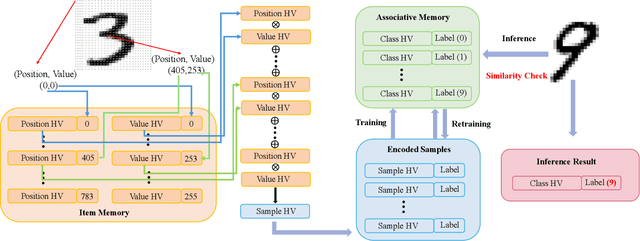

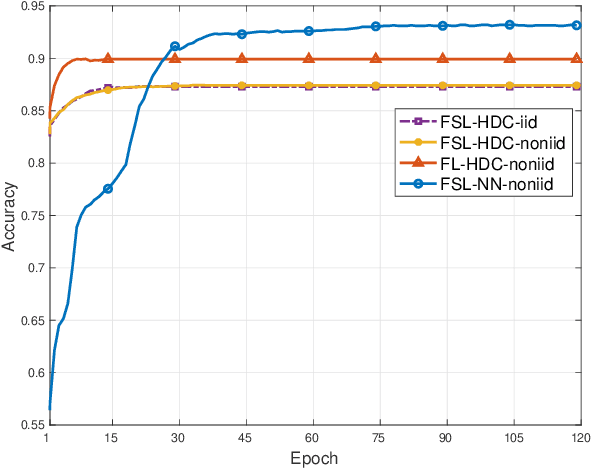
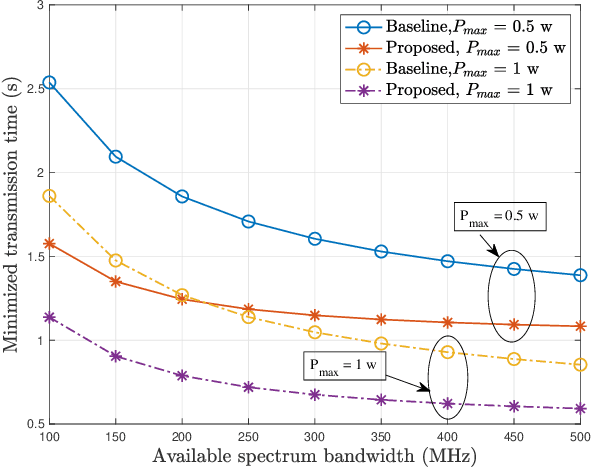
Abstract:The Metaverse, a burgeoning collective virtual space merging augmented reality and persistent virtual worlds, necessitates advanced artificial intelligence (AI) and communication technologies to support immersive and interactive experiences. Federated learning (FL) has emerged as a promising technique for collaboratively training AI models while preserving data privacy. However, FL faces challenges such as high communication overhead and substantial computational demands, particularly for neural network (NN) models. To address these issues, we propose an integrated federated split learning and hyperdimensional computing (FSL-HDC) framework for emerging foundation models. This novel approach reduces communication costs, computation load, and privacy risks, making it particularly suitable for resource-constrained edge devices in the Metaverse, ensuring real-time responsive interactions. Additionally, we introduce an optimization algorithm that concurrently optimizes transmission power and bandwidth to minimize the maximum transmission time among all users to the server. The simulation results based on the MNIST dataset indicate that FSL-HDC achieves an accuracy rate of approximately 87.5%, which is slightly lower than that of FL-HDC. However, FSL-HDC exhibits a significantly faster convergence speed, approximately 3.733x that of FSL-NN, and demonstrates robustness to non-IID data distributions. Moreover, our proposed optimization algorithm can reduce the maximum transmission time by up to 64% compared with the baseline.
FIRST: Teach A Reliable Large Language Model Through Efficient Trustworthy Distillation
Aug 22, 2024Abstract:Large language models (LLMs) have become increasingly prevalent in our daily lives, leading to an expectation for LLMs to be trustworthy -- - both accurate and well-calibrated (the prediction confidence should align with its ground truth correctness likelihood). Nowadays, fine-tuning has become the most popular method for adapting a model to practical usage by significantly increasing accuracy on downstream tasks. Despite the great accuracy it achieves, we found fine-tuning is still far away from satisfactory trustworthiness due to "tuning-induced mis-calibration". In this paper, we delve deeply into why and how mis-calibration exists in fine-tuned models, and how distillation can alleviate the issue. Then we further propose a brand new method named Efficient Trustworthy Distillation (FIRST), which utilizes a small portion of teacher's knowledge to obtain a reliable language model in a cost-efficient way. Specifically, we identify the "concentrated knowledge" phenomenon during distillation, which can significantly reduce the computational burden. Then we apply a "trustworthy maximization" process to optimize the utilization of this small portion of concentrated knowledge before transferring it to the student. Experimental results demonstrate the effectiveness of our method, where better accuracy (+2.3%) and less mis-calibration (-10%) are achieved on average across both in-domain and out-of-domain scenarios, indicating better trustworthiness.
DiscipLink: Unfolding Interdisciplinary Information Seeking Process via Human-AI Co-Exploration
Aug 01, 2024



Abstract:Interdisciplinary studies often require researchers to explore literature in diverse branches of knowledge. Yet, navigating through the highly scattered knowledge from unfamiliar disciplines poses a significant challenge. In this paper, we introduce DiscipLink, a novel interactive system that facilitates collaboration between researchers and large language models (LLMs) in interdisciplinary information seeking (IIS). Based on users' topics of interest, DiscipLink initiates exploratory questions from the perspectives of possible relevant fields of study, and users can further tailor these questions. DiscipLink then supports users in searching and screening papers under selected questions by automatically expanding queries with disciplinary-specific terminologies, extracting themes from retrieved papers, and highlighting the connections between papers and questions. Our evaluation, comprising a within-subject comparative experiment and an open-ended exploratory study, reveals that DiscipLink can effectively support researchers in breaking down disciplinary boundaries and integrating scattered knowledge in diverse fields. The findings underscore the potential of LLM-powered tools in fostering information-seeking practices and bolstering interdisciplinary research.
Multi-attribute Auction-based Resource Allocation for Twins Migration in Vehicular Metaverses: A GPT-based DRL Approach
Jun 08, 2024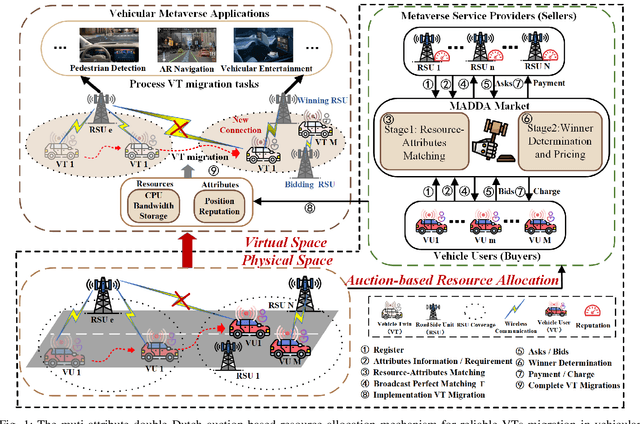
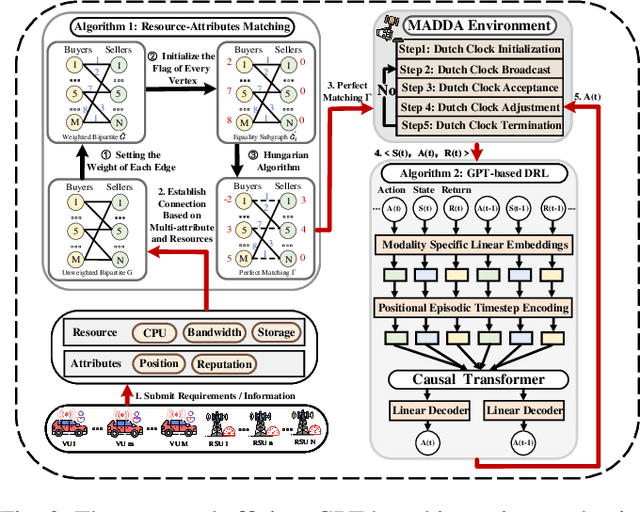
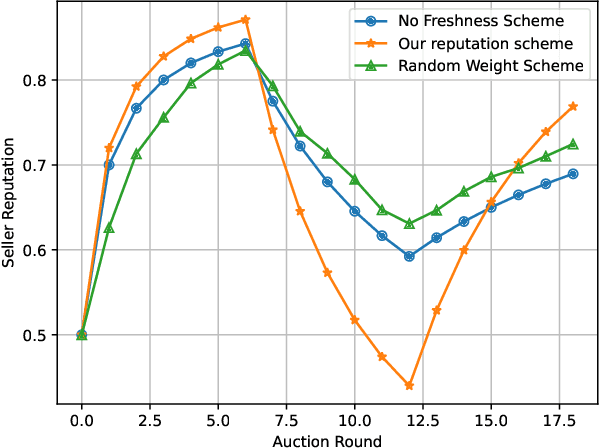
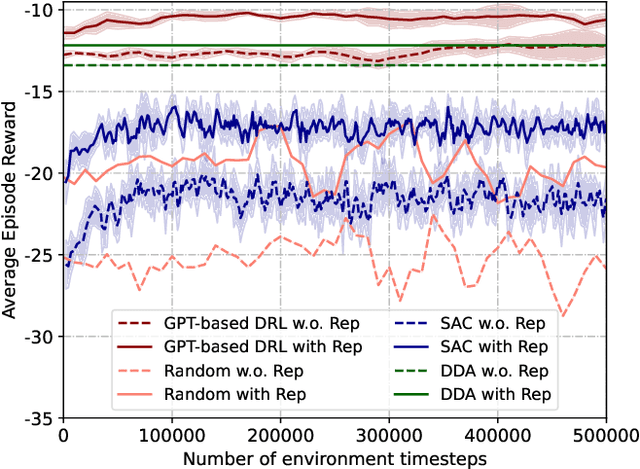
Abstract:Vehicular Metaverses are developed to enhance the modern automotive industry with an immersive and safe experience among connected vehicles and roadside infrastructures, e.g., RoadSide Units (RSUs). For seamless synchronization with virtual spaces, Vehicle Twins (VTs) are constructed as digital representations of physical entities. However, resource-intensive VTs updating and high mobility of vehicles require intensive computation, communication, and storage resources, especially for their migration among RSUs with limited coverages. To address these issues, we propose an attribute-aware auction-based mechanism to optimize resource allocation during VTs migration by considering both price and non-monetary attributes, e.g., location and reputation. In this mechanism, we propose a two-stage matching for vehicular users and Metaverse service providers in multi-attribute resource markets. First, the resource attributes matching algorithm obtains the resource attributes perfect matching, namely, buyers and sellers can participate in a double Dutch auction (DDA). Then, we train a DDA auctioneer using a generative pre-trained transformer (GPT)-based deep reinforcement learning (DRL) algorithm to adjust the auction clocks efficiently during the auction process. We compare the performance of social welfare and auction information exchange costs with state-of-the-art baselines under different settings. Simulation results show that our proposed GPT-based DRL auction schemes have better performance than others.
 Add to Chrome
Add to Chrome Add to Firefox
Add to Firefox Add to Edge
Add to Edge